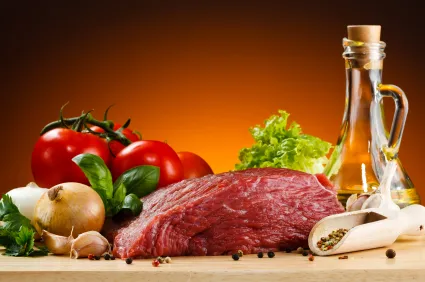
Which Mediterranean Diet is Right for You?
Interest in the Mediterranean Diet began with the attention of Ancel Keys in the 1950’s when he learned of the historically low incidence of heart disease in Italy. Keys described the diet and then made an error of scientific judgment. He assumed the post-war, low-cholesterol, low-fat diet he saw was the cause for the low rate of heart disease. Keys pursued his hypothesis with further population studies, and his theory that dietary fat causes heart disease has been accepted as fact by most conventional medical writers for decades.
The recent work of Gary Taubes, “Good Calories Bad Calories” and “Why We Get Fat”, has focused attention on the flaws in Keys’ work. Taubes and others have re-examined the original data, and pose an opposite theory that dietary carbohydrates, and particularly processed and refined grain carbohydrates, are the foods that cause heart disease.
Despite disagreement about the specifics, interest in the Mediterranean Diet persists. Both in current observational studies and historical surveys, there is reason to consider that the food choices in the Mediterranean region could contribute to good health. Particular attention has been paid to the diet on the island of Crete. Unlike Naples or Athens, dietary patterns on Crete have not been modernized, and only Crete continues as a modern “cold spot” for heart disease.
Information from two sources “Flavors of Greece”, by Rosemary Barron, and “The Jungle Effect”, by Daphne Miller, M.D., can give us a picture of the foods eaten by the heart healthy people of Crete. In the words of Daphne Miller, Crete is “the cold spot that nutritionists and other health experts are referring to (whether they know it or not) when they sing the praises of the Mediterranean diet.”
The Mediterranean Diet, Crete style
Protein
- Meats are raised locally. Animals graze freely on grass, and are harvested without grain-fattening. Chicken is the only lean meat; other choices are lamb, goat and pork. Wild game and homemade (nitrate free) sausages are enjoyed. Free ranging animals produce meat that is higher in Omega 3’s and lower in overall fat; this is a completely different meat than conventional grocery store meats, which should be avoided. The fat that does come with the meat may be eaten because it is healthy (organic) and aids protein digestion and assimilation.
- Organ meats. Kidneys, liver and spleen are enjoyed and absolutely must come from organically raised, free-range animals.
- Seafood is eaten frequently. Fish and shellfish are consumed as available. Once or twice weekly is a good frequency.
- Eggs come from free-ranging chickens. Average egg consumption is ten weekly, but enjoy more if you like. Notice the color of the yolk: the more orange the color, the higher the food value.
- Dairy comes from goats raised on grass. Goat’s milk is higher in fat than cow’s milk, is more easily digested, and is enjoyed as milk, cheese, and yogurt. When goat milk products are not available, substitute milk from cows raised on grass. So-called Greek yogurt is usually full fat yogurt with the whey (protein!) strained out, not a good choice. Other varieties are thickened with non-fat milk solids (oxidized, another bad choice). Full fat yogurt from grass fed animals is healthiest.
Fats
- Olive oil is extra-virgin and organic. No other oils are used. Olive oil is a dressing on foods, not used for frying.
- Animal fat is used for roasting meat and all frying. No surprise: this fat comes from the same healthy animals that provide the meat!
Vegetables and Fruits
- Wild leafy greens are the favorite. Commercial food gatherers can substitute anything leafy, from kale and collard greens to romaine lettuce. The more intense the color, the higher the food value. Eat with butter or cheese to help absorb the fat-soluble vitamin A in the greens.
- Other vegetables are good too. Artichokes and eggplant provide excellent fiber sources and cook well with herbs, meats and olive oil.
- Fruits become dessert. Grapes or tree-fruit are the main fruits chosen, and usually eaten after a meal as dessert.
Grains and Beans*
- Grains are eaten whole. The wheat issue is complex and deserves its own article. Wheat grown for centuries on small plots in the Mediterranean cannot be compared to “amber waves of grain” that grow “rolling waves of fat” on American midsections. These wheats are completely different varieties with different properties than the wheat we are used to. The closest comparison for US breads would be artisanal bread grown with local and mixed grains, ideally sprouted or sourdough.
- Legumes are side dishes. Many varieties of beans are soaked, cooked, and drowned in herbs and oils as a side dish, or occasionally used in stews.
*Grains and beans come with only a partial recommendation from me. For those battling excess weight, eliminate this group to reduce carbohydrate grams.
Wines and Spirits
- Red wine is the favorite. Share a glass of organic red wine with friends over a light meal or snacks made from the above choices.
One more thing
Have you ever traveled to Mediterranean countries? People carry string bags on their walk to their local markets, buy the day’s food, chat with friends, and return home to prepare a family meal. Corner markets are more abundant and well-stocked in Italy than they are in many American neighborhoods, so we might have to work to incorporate the exercise, freshness, and community that have historically been part of the Mediterranean Diet. That sounds like a good thing, doesn’t it?

